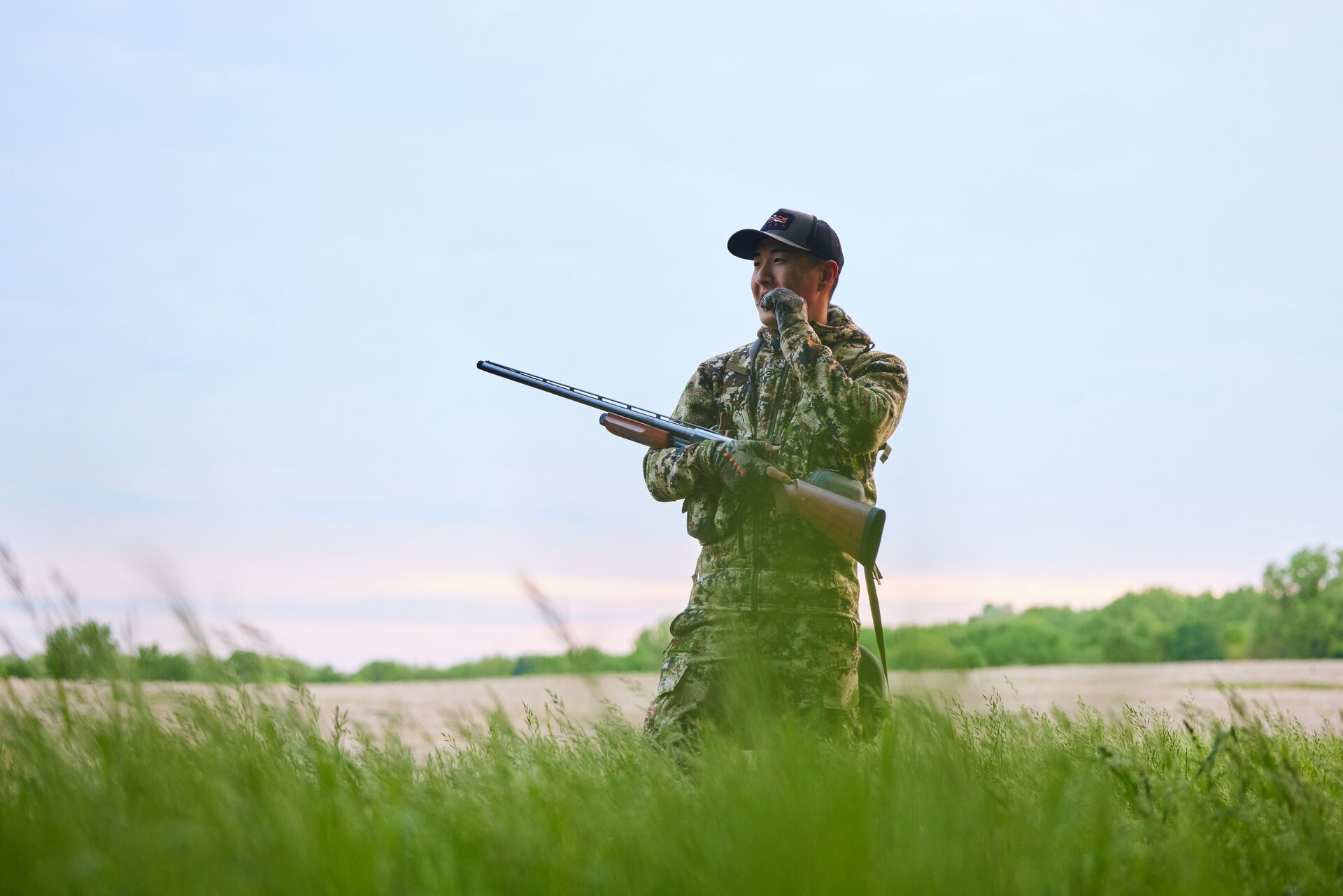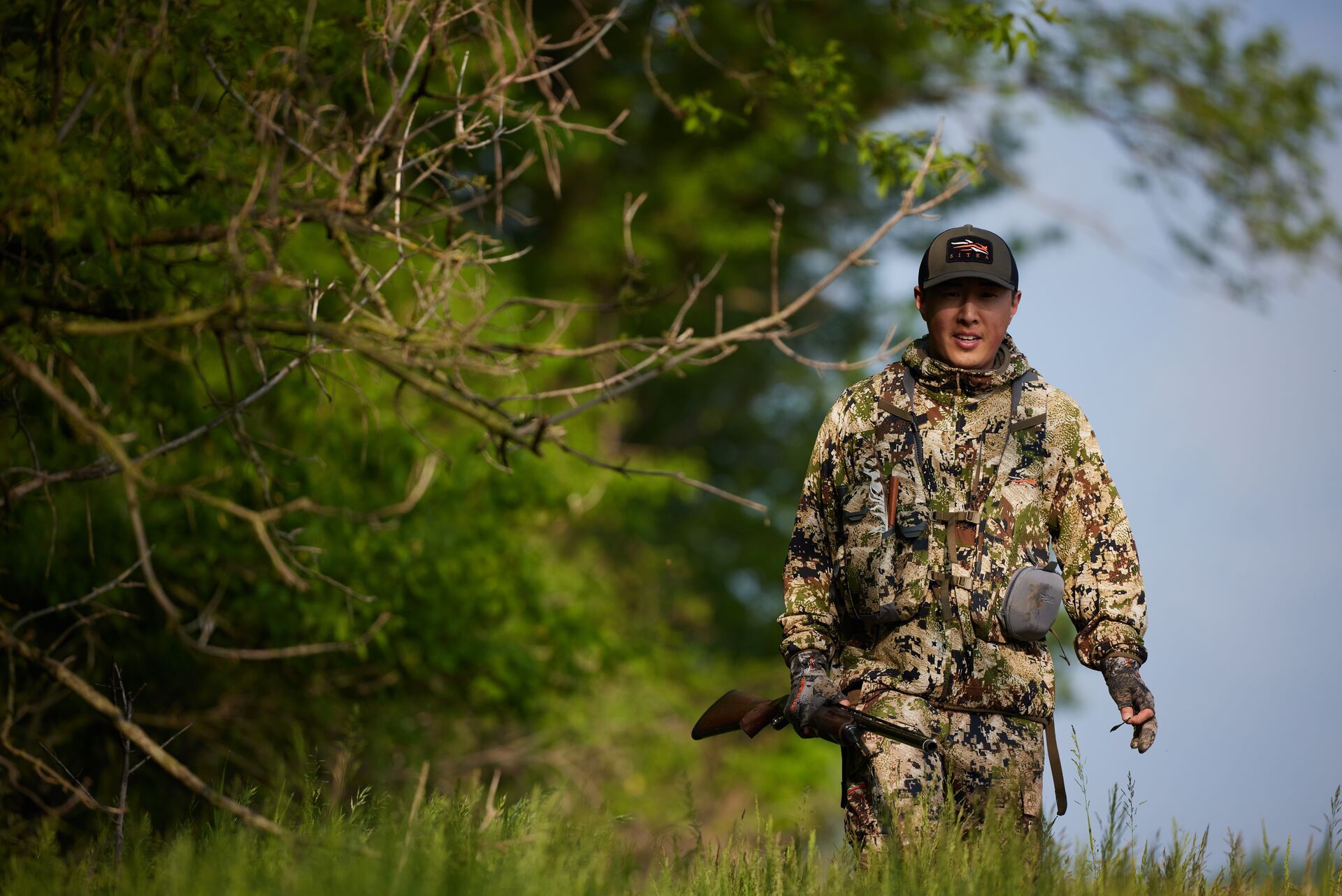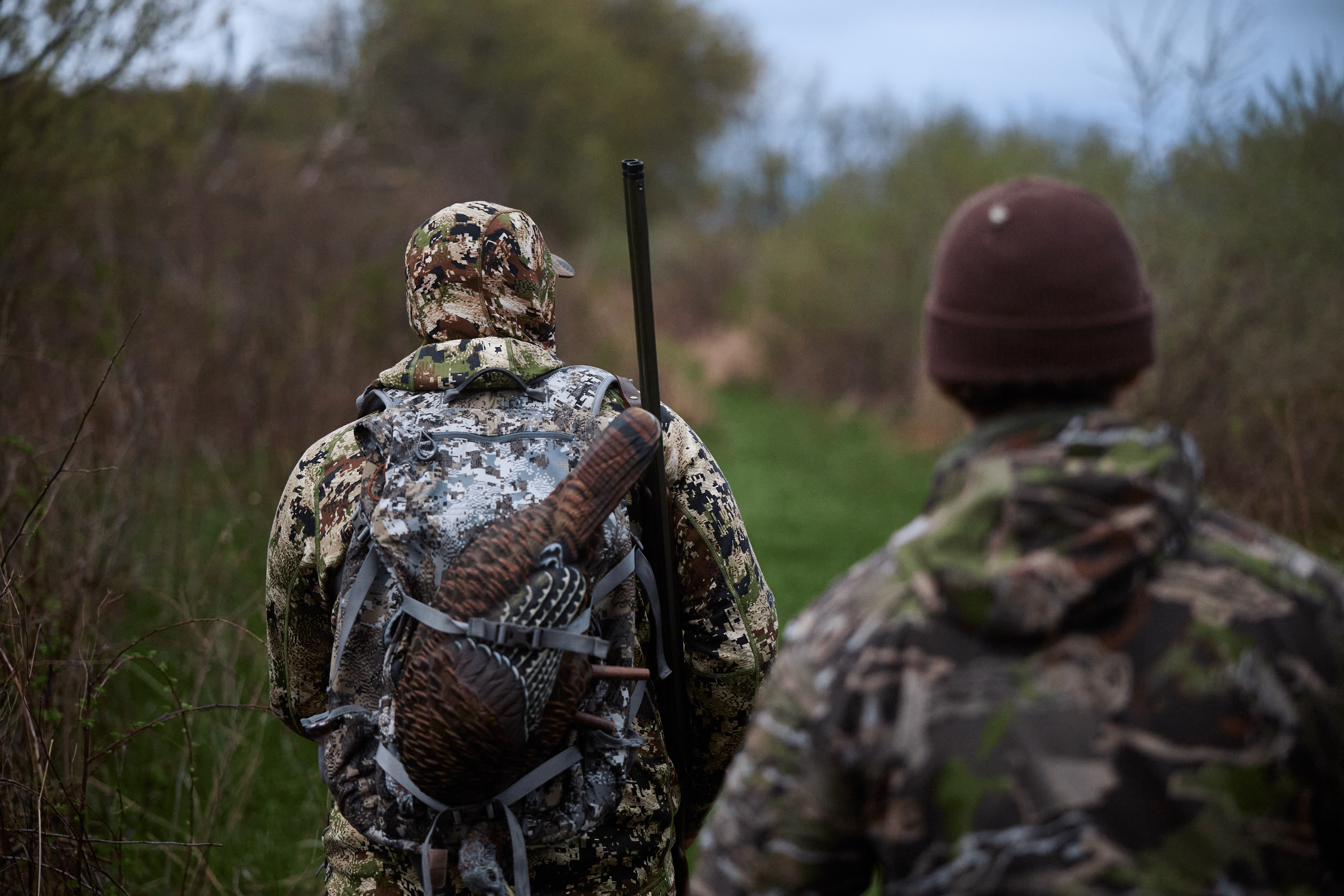Field Guide / Turkey
The HuntWise Turkey Hunting Guide

15 Minute Read
To a hunter, spring is all about the sound of a gobbling turkey or a tom in full strut coming into your calls. When spring arrives, hunters brush off the winter lull and prep for another season of hunting.
The best way to start the season is to hunt the kings of the small game world: the Wild Turkey, a bird worth naming a whiskey after.
We're here to help you bring home the turkey this season!
We've put together our ultimate guide to spring turkey hunting. With these turkey hunting tips and tricks, we help you with everything you need to know to hunt more effectively.
Remember: strategy is key when you're hunting turkeys. In addition to the expert insights in this guide, utilize a hunting and mapping tool like HuntWise to maximize your hunt!
Chapter 1: All About the Wild Turkey
The wild turkey was hunted nearly to extinction by the early 1900s when the population reached a low of around 30,000 birds. However, restoration programs across North America through organizations like the National Wild Turkey Federation have increased the numbers to about seven million today.
Identifying Turkey Species
If you are a turkey hunter, you have certainly heard of the famous Grand Slam. To achieve this feat, hunters must register a harvest of the four most common wild turkey species: the Rio Grande, Eastern, Merriam's, and Osceola turkeys.
However, those four common species are not the only species of wild turkey. Here are six!
- Eastern Turkey – Found in the eastern half of the United States, eastern turkeys stick to forested areas and open grasslands. They are the most common subspecies. You'll find them snacking on beetles, grasshoppers, insects, tree nuts, and even acorns.
- Osceola Turkey – Named after a Seminole Chief, these turkeys are found in central and southern Florida. They are one of the more challenging turkeys to find since they are only seen in one state. They typically eat lizards, blackberries, and acorns.
- Merriam's Turkey – Found in the mountain regions of the western United States, these turkeys are very similar to the Rio Grande turkey and tend to overlap regions. So make sure you aren't harvesting a hybrid if you are trying to achieve your slam. These turkeys can be identified by the whiteness of their tail fan.
- Rio Grande Turkey - This species is found in the south-central plains, Northeast Mexico, and Texas. They have the same diet as an eastern turkey but a very unique gobble that will be hard to mistake for another type of turkey.
- Gould's Turkey - Found in parts of Southern Arizona and New Mexico, these turkeys can be identified by white tips on their tail feathers and long legs.
- Ocellated Turkey - Found in Mexico, the beautiful colors make this turkey the most unique. They have colors similar to the peacock, including ocellated eye-like markings.
Whether you plan to go for a turkey slam or are simply ready to hunt wild turkeys in your area, understanding the species and how to identify them can help you have a more successful hunt.
What's In a Turkey's Diet?
The wild turkey's diet is typically omnivorous. To find their food, turkeys scratch their feet on the ground to uncover their meal.
Constantly foraging for nuts, seeds, berries, small reptiles, succulents, plant foliage, and insects, turkeys have quite a variety.
By knowing where turkeys can be found and what they eat, you can now identify the gender of a turkey based on its poop. Male droppings are typically "j-shaped," while female droppings take on a more "spiral or curlycue" shape.
Turkey Have Super Senses
Turkeys are known for their super vision and hearing, making them challenging to hunt.
In the book, "The Wild Turkey Biology and Management," compiled and edited by Dr. James G. Dickson, we learn that wild turkeys have flattened corneas and can see colors to some degree. Their eyes are on the side of their head, meaning they have a monocular, periscopic vision.
Turkeys use their vision to locate food and potential threats. They have the ability to detect movement and process details quite quickly. This is one reason why sitting still is very important when hunting.
When turkeys hear a noise, they immediately look in the direction of the sound, allowing them to react quickly to predators. A turkey's senses make them challenging to hunt.
When you find your spot to watch for turkey activity, maintain proper position, as you won't be able to move as soon as they are within sight of you. Or utilize a hunting blind to hide your movements.
Chapter 2: Turkey Hunting Season
When can hunters hunt wild turkey? The good news is that turkeys are active in the spring and fall, providing two opportunities each year to harvest a turkey.
The Spring Turkey Season
A turkey's peak breeding season is in the spring. This time frame is when the toms strut around and show off to attract the hens, making spring the best time to hunt turkeys.
In spring, turkeys are the most vocal, trying to attract hens with their gobble. Hunters can use this to their advantage by mimicking the sounds of hens to call them in.
Turkeys are also more spread out in the spring, not yet in flocks, so this can also be an advantage for hunters. It's easier to lure and trick toms into coming toward your calls.
April through May is prime turkey season for most states, with states like Florida starting turkey season as early as March. Check local laws and regulations to determine your region's specific dates for turkey hunting.
You can find this information online or through the HuntWise app.
The Fall Turkey Season
Hunters can target males or females during the fall turkey season, depending on local guidelines.
It's not the most common time for turkey hunters to be out, but when whitetail season is in effect, it's nice to have a tag in your pocket if a turkey walks by. At this time of year, turkeys are in larger flocks, making it more difficult to hunt or call in.
Chapter 3: Be Prepared for (Almost) Anything With the Right Turkey Hunting Gear
When turkey season is right around the corner, make sure you are fully equipped with the essentials for a successful hunt.
HuntWise users have access to our gear program, saving you up to 50% on over 75+ top hunting brands.
What should you add to your gear before turkey season gets here? From clothing to calls and blinds, here are a few of our recommendations.
Stay Hidden With Turkey Hunting Clothing
The key to success with your hunting clothing is to cover yourself head to toe and avoid being seen at all costs. This includes a face covering and thin gloves.
In addition to helping you stay hidden from turkeys, the mosquitoes can be brutal this time of year. The face-covering will help!
Pack Your Gear In a Hunting Vest
Most turkey hunters bring a lot of gear into the field. They carry multiple calls, a flashlight, strikers, water, decoys, shells, and snacks.
Adding a good vest to your equipment is a smart investment to keep your gear secure, organized, and silent. Some vests even have a nice seat attached to the bottom for those longer sits.
Bring Multiple Turkey Calls
Hunters rely on calls to help bring gobblers into shooting range. Having a variety of calls and learning to use them can make or break your hunt.
A box call is great for beginners, as it's the easiest to use for a consistent sound. You can also use a slate call, mouth call, or locator call (such as a crow call) to get a turkey to do a shock gobble.
The goal with a call is to imitate the hen as much as possible or get a gobble fired up to reel him in. Some basic calls include cluck, purr, putt, and yelp.
Conceal Your Movement in a Ground Blind
Hunting from a ground blind can make things much quicker and easier for hunters.
Blinds can be set up in just a few minutes and fully enclose you to prevent being spotted. Then, if you decide to switch locations, ground blinds don't need to be brushed in and are very easy to move around.
Don't Forget a Hunting Weapon
This might seem obvious, but bringing the right hunting weapon is important for successfully harvesting a turkey!
A shotgun is the most common weapon for hunting a turkey. A black camouflage shotgun will work just fine, as the key is not to draw attention. Shotgun gauges range from 10, 12, 16, and 20 gauge.
You might also wonder about the best choke tube for turkey hunting. A full choke is the best option, as it will give you a tighter pattern with a lethal shot at 30-40 yards.
The most popular turkey load choice is 4-6 shot because heavier pellets have a more packed downrange punch. Some hunters prefer hunting turkey with a bow, which is a little more challenging.
With a bow, use a standard broadhead for the body and a guillotine-style broadhead to remove the head.
Bring Turkey Decoys (When Appropriate)
When gathering your gear for your next hunt, consider whether you should use a decoy at all.
To successfully hit your target, the goal is to get the turkey within 30-40 yards of you. So, if you're hunting in the woods with low visibility, you can probably leave the decoy at home. The tom will be looking for the hen hiding in the trees, so keep calling until you can get a shot.
However, if you're hunting a field edge with open visibility, use a hen or jake decoy. The turkey will want to breed or fight. Hens are often the best decoys since that's what the toms are looking for.
Another option is to use a hen and jake combination, as this will challenge most toms, including two-year-old turkeys that can be aggressive and a little reckless.
Avoid using a strutter decoy, as this could scare off most turkeys. However, it might not be a bad idea to use one in a confined area with a dominant bird.
Chapter 4: Tips and Tricks for a Successful Turkey Hunt
With a location scouted and the right gear, it's time to hunt your turkey when the spring season opens! Keep reading for a few of our best tips and tricks to harvest a turkey this season.
Understanding the Turkey's Habitat
Turkeys, like most animals, have basic needs. They need food, water, trees to roost in, open fields, and plenty of cover. As long as they have enough cover to hide, they can survive.
Food plots aren't just for whitetails – turkeys (and hunters) can benefit from these, too. Turkeys are attracted to grub and green foliage.
Additionally, plots of clover and winter wheat tend to attract a lot of bugs, which is what hens need to produce eggs, so don't hesitate to plant a plot for multiple uses.
Scouting and Patterning
Turkeys have the same habits, travel areas, fields, and open spots in the woods for feeding and showing off to the hens. When preparing for your time in the field, proper scouting techniques could make or break your hunt.
To avoid wasting valuable time, pattern these birds by doing some early morning listening and glassing from the road. Find out where they roost, then sneak in on them on an early morning hunt.
Turkeys are usually out in the open at dawn, midmorning, and evening. Knowing this will make it easy to see the strutting toms and how many hens he has with him. If you see a tom with fewer hens, it will be easier to lure him away.
Finding The Roost
Finding a turkey's roost is one of the most important factors in achieving success in the woods. When the sun goes down, turkeys aren't worried about showing off. They are more interested in finding a safe place to sleep.
Wherever you see these birds after sunset, you'll have a good idea of where they will roost for the night. You might even hear them by listening for breaking branches or wings flapping. If you can pinpoint this area the night before your hunt, you can set up nearby in the morning.
Calling Turkeys In
Less is more when it comes to calling in turkeys.
One of the biggest questions we get is how often you should call when turkey hunting. A good rule of thumb is to call once every 5-10 minutes, despite how fired up the turkey is.
Turkeys have a brain the size of a pea, so while they may not be the smartest animal in the field, they are paranoid and have impeccable eyesight and hearing. This is where your patience and the ability to sit still and wait for the shot comes in.
One call to avoid is the "purr and cluck" call, commonly used to bring in a tom. Hens use this call when they are mad, so unless you are trying to keep a hen in the area, avoid using this call.
Hunting the Weather
Temperature plays a huge role in turkey hunting and whether or not the turkeys will be talking. They will slow down if it's colder and not be as vocal if it's windy. They also won't be able to hear you or your calls as well.
Maximize your hunt by understanding the weather and how it impacts turkey movement on the days you want to hunt, then plan your gear, calls, and strategy appropriately.
Chapter 5: Using HuntWise to Hunt Turkeys
Strategy is key when you're hunting turkeys. Fortunately, turkey hunting in 2024 has become easier with new innovative tools that make your experience more enjoyable and successful.
If you're serious about turkey hunting and want to maximize your time chasing gobblers, HuntWise has you covered.
From planning your turkey hunts to e-scouting, the HuntWise app can help you stay one step ahead with live weather reports, weather forecasts, sunrise and sunset times, and species-specific turkey predictions.
Here is a look at the top tools in the app to help prepare for and improve your spring turkey season.
E- Scouting and Public Land
March is the perfect time to start e-scouting land for your first turkey hunt of the season. If it's wet, snowy, or rainy, and you're stuck indoors, take the opportunity to get to know the HuntWise app to scout a new field or search for potential private land.
The mapping layers make it easy to identify public land and access points. You can also check for smaller plots of land that might be overlooked by other hunters.
Apply Markers
Using markers is one of the most valuable tools within the HuntWise app.
Mark any area of interest, including roosting locations, turkey scat, and entry trails. Then, you can easily share these points with your buddies, making this feature even more useful.
Markers are great for navigating to your hunting spots and can also help you see the larger picture. They allow you to see how different turkey variables sync with each other and how turkeys interact with food, roost locations, and travel paths.
Understanding this information and these relationships will make you a better hunter when scouting new areas. You'll also be better equipped to adjust your strategy when things go sideways.
Use Offline Features to Find Turkey Hunting Areas
It's not uncommon to get into a hunting location without cell service, especially when you are deep in the woods. So, before heading out into the field, check another beneficial feature within the app – the cell coverage map layer – so you can plan ahead if service is unavailable.
If you won't have cell service during your hunt (or if you're note sure), download your HuntWise maps and markers for access without a cell signal. You can still utilize your GPS and navigate without a cell signal if you download the map offline.
Topographical Maps Help Locate Turkey Roosting Locations
Turkeys love to roost in higher elevations, whether you're hunting the plains or the high mountains.
The HuntWise topographic map feature can help you uncover turkey routes and where they may be headed to feed. The topographic map shows the draws and valleys or which swamps or cliff sides to avoid, helping you outsmart turkeys in their own habitat.
Using HuntCast To Choose The Best Time To Turkey Hunt
As we already mentioned, whether it's sleet, rain, heat, or snow, the weather certainly affects the turkeys' patterns and can be unpredictable. Knowing how the turkeys might behave when unexpected weather hits can help you punch your tag.
Using the HuntCast feature in your HuntWise app helps you stay one step ahead with live weather reports, weather forecasts, sunrise/sunset times, and species-specific turkey predictions.
Chapter 6: Clean and Cook Your Turkey
Plucking, skinning, and quartering: just when you thought the work was done after a successful hunt, it's time to prepare your harvest for a meal (or several).
Plucking a turkey is the perfect way to prepare your turkey to be roasted, smoked, or even deep-fried. Pluck the turkey's feathers to preserve the skin and maintain moisture.
However, it's a tedious process and not everyone's favorite way to prepare a turkey, so skinning is another option.
Skin the bird, then fry or grill the meat. Work along the breastbone to remove the breast meat, then work down and around each leg, utilizing as much of the bird as possible. Find your favorite recipes and enjoy your bird to celebrate a successful turkey hunting season!
Get Started (or Refine Your Turkey Hunt) With the HuntWise App
Turkey hunting can be a challenge experienced hunters enjoy every season, but it's also an excellent introduction to the sport of hunting. Waking up early to see the sunrise or enjoying the peace and quiet of the woods is part of what makes it worthwhile.
Success isn't guaranteed, but with the knowledge in this turkey hunting guide and the right tools, you set yourself for more success hunting these elusive birds.
Download the HuntWise app and explore some of the features we mentioned today for free! Then, enjoy a successful turkey hunt this season.
Content updated January 24, 2024
More Content Like This

What to Wear Turkey Hunting in the Spring
With cool mornings, warm afternoons, and chilly evenings, putting together a spring turkey hunting kit can initially seem like a challenge. Luckily, the process is relatively straightforward. However, with some sensible layering, carefully selected ...Read More
Read More
When Is Turkey Season, Minnesota?
From the exhilarating pursuit of turkeys across vast plains to the strategic navigation of expansive woodlands, North Minnesota offers a turkey hunting experience that is not just a sport but a journey steeped in history and strong tradition. Read More
Read More
When Is Virginia Turkey Season?
With a generous hunting season that covers both spring and fall, backed by a strong hunting tradition, it's no surprise that Virginia is a hot spot for turkey hunters from all over the country. Read More
Read More Turkey
TurkeyWhat to Wear Turkey Hunting in the Spring
By Nate Huizenga | 04/15/2025With cool mornings, warm afternoons, and chilly evenings, putting together a spring turkey hunting kit can initially seem like a challenge. Luckily, the process is relatively straightforward. However, with some sensible layering, carefully selected ...Read More
Read More Turkey
TurkeyWhen Is Turkey Season, Minnesota?
By Teri Williams | 04/18/2024From the exhilarating pursuit of turkeys across vast plains to the strategic navigation of expansive woodlands, North Minnesota offers a turkey hunting experience that is not just a sport but a journey steeped in history and strong tradition. Read More
Read More Turkey
TurkeyWhen Is Virginia Turkey Season?
By Teri Williams | 04/08/2024With a generous hunting season that covers both spring and fall, backed by a strong hunting tradition, it's no surprise that Virginia is a hot spot for turkey hunters from all over the country. Read More
Read More
1 of 3